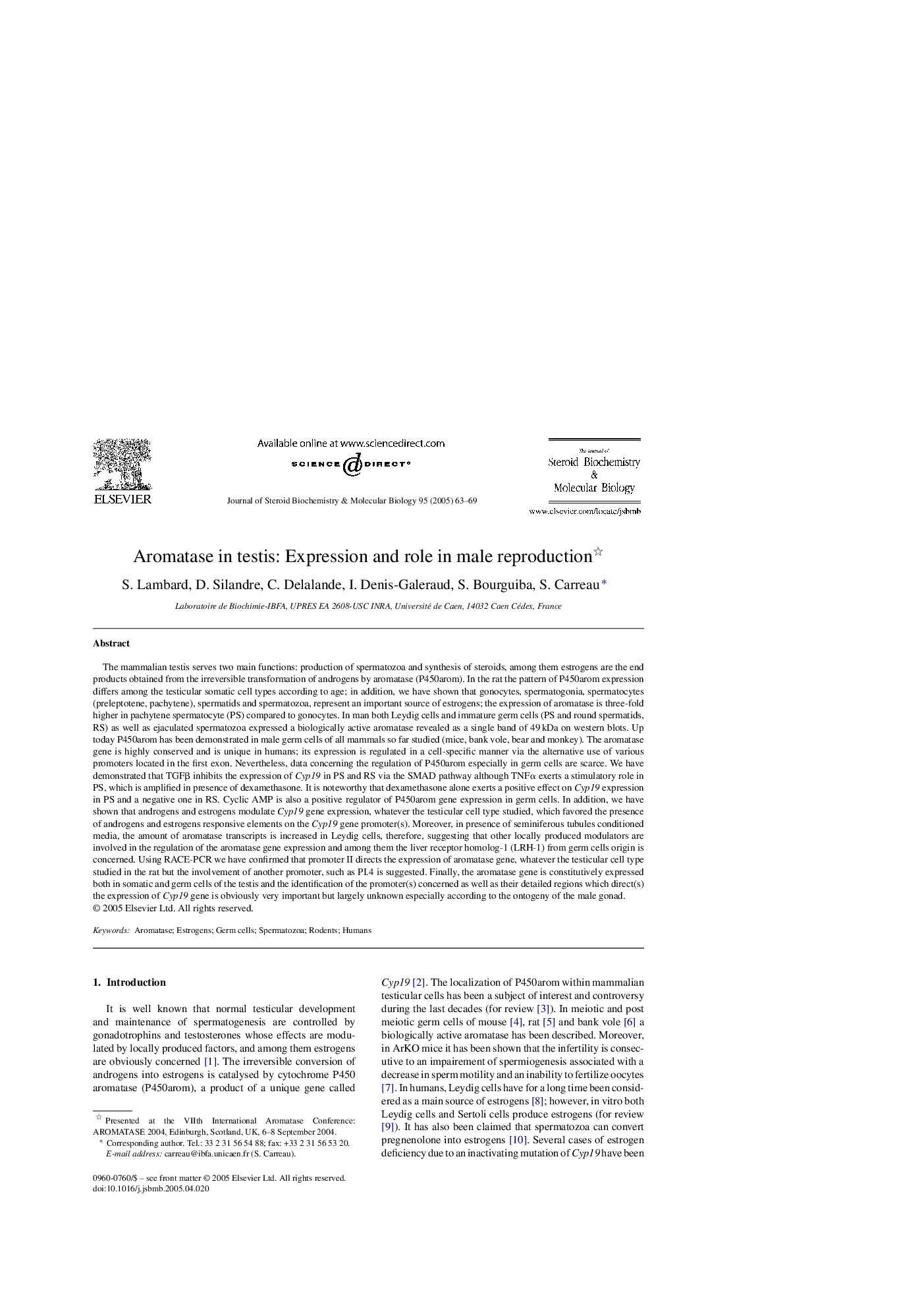| کد مقاله | کد نشریه | سال انتشار | مقاله انگلیسی | نسخه تمام متن |
|---|---|---|---|---|
| 9892124 | 1541101 | 2005 | 7 صفحه PDF | دانلود رایگان |
عنوان انگلیسی مقاله ISI
Aromatase in testis: Expression and role in male reproduction
دانلود مقاله + سفارش ترجمه
دانلود مقاله ISI انگلیسی
رایگان برای ایرانیان
کلمات کلیدی
موضوعات مرتبط
علوم زیستی و بیوفناوری
بیوشیمی، ژنتیک و زیست شناسی مولکولی
زیست شیمی
پیش نمایش صفحه اول مقاله

چکیده انگلیسی
The mammalian testis serves two main functions: production of spermatozoa and synthesis of steroids, among them estrogens are the end products obtained from the irreversible transformation of androgens by aromatase (P450arom). In the rat the pattern of P450arom expression differs among the testicular somatic cell types according to age; in addition, we have shown that gonocytes, spermatogonia, spermatocytes (preleptotene, pachytene), spermatids and spermatozoa, represent an important source of estrogens; the expression of aromatase is three-fold higher in pachytene spermatocyte (PS) compared to gonocytes. In man both Leydig cells and immature germ cells (PS and round spermatids, RS) as well as ejaculated spermatozoa expressed a biologically active aromatase revealed as a single band of 49 kDa on western blots. Up today P450arom has been demonstrated in male germ cells of all mammals so far studied (mice, bank vole, bear and monkey). The aromatase gene is highly conserved and is unique in humans; its expression is regulated in a cell-specific manner via the alternative use of various promoters located in the first exon. Nevertheless, data concerning the regulation of P450arom especially in germ cells are scarce. We have demonstrated that TGFβ inhibits the expression of Cyp19 in PS and RS via the SMAD pathway although TNFα exerts a stimulatory role in PS, which is amplified in presence of dexamethasone. It is noteworthy that dexamethasone alone exerts a positive effect on Cyp19 expression in PS and a negative one in RS. Cyclic AMP is also a positive regulator of P450arom gene expression in germ cells. In addition, we have shown that androgens and estrogens modulate Cyp19 gene expression, whatever the testicular cell type studied, which favored the presence of androgens and estrogens responsive elements on the Cyp19 gene promoter(s). Moreover, in presence of seminiferous tubules conditioned media, the amount of aromatase transcripts is increased in Leydig cells, therefore, suggesting that other locally produced modulators are involved in the regulation of the aromatase gene expression and among them the liver receptor homolog-1 (LRH-1) from germ cells origin is concerned. Using RACE-PCR we have confirmed that promoter II directs the expression of aromatase gene, whatever the testicular cell type studied in the rat but the involvement of another promoter, such as PI.4 is suggested. Finally, the aromatase gene is constitutively expressed both in somatic and germ cells of the testis and the identification of the promoter(s) concerned as well as their detailed regions which direct(s) the expression of Cyp19 gene is obviously very important but largely unknown especially according to the ontogeny of the male gonad.
ناشر
Database: Elsevier - ScienceDirect (ساینس دایرکت)
Journal: The Journal of Steroid Biochemistry and Molecular Biology - Volume 95, Issues 1â5, May 2005, Pages 63-69
Journal: The Journal of Steroid Biochemistry and Molecular Biology - Volume 95, Issues 1â5, May 2005, Pages 63-69
نویسندگان
S. Lambard, D. Silandre, C. Delalande, I. Denis-Galeraud, S. Bourguiba, S. Carreau,